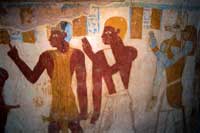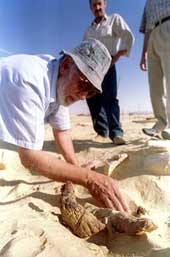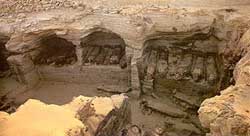|
Set in a depression
covering over 2000 sq. km., Bahariya Oasis is surrounded by
black hills made up of ferruginous quartzite and dolorite. Most
of the villages and cultivated land can be viewed from the top
of the 50-meter-high Jebel al-Mi'ysrah, together with the
massive dunes which threaten to engulf some of the older
settlements.
 The Oasis was a major agricultural center during the Pharaonic
era, and has been famous for its wine as far back as the Middle
Kingdom. During the fourth century, the absence of Roman rule
and violent tribes in the area caused a decline as some of the
oasis was reclaimed by the sand. The Oasis was a major agricultural center during the Pharaonic
era, and has been famous for its wine as far back as the Middle
Kingdom. During the fourth century, the absence of Roman rule
and violent tribes in the area caused a decline as some of the
oasis was reclaimed by the sand.
Wildlife is plentiful, especially birds such as wheatears; crops
(which only cover a small percentage of the total area) include
dates, olives, apricots, rice and corn.
There are a number of springs in the area, some very hot, such
as Bir ar-Ramla but probably the best is Bir al-Ghaba, about 10
miles north east of Bawiti. There is also Bir al-Mattar, a cold
springs which poors into a concrete pool
Otherwise near the Oasis is the Black and White deserts, though
traveling to the White desert seems not practical from the
oasis. The Black Desert was formed through wind erosion as the
nearby volcanic mountains were spewed over the desert floor.
Finally, there are the ruins of a 17th Dynasty temple and
settlement, and nearby tombs where birds were buried.
Bawiti, Bahareya’s capital , is by far the largest village in
the Bahariya Oasis with some 30,000 inhabitants. The town center
is modern, while outside the center are mud-brick houses.
Recently, the town has received considerable press due to the
find of a huge (possibly the largest) necropolis of mommies from
the Greco-Roman era.
 Over time, the Bahariya Oasis has had a number of different
names. It has been called the Northern Oasis, the Little Oasis,
Zeszes, Oassis Parva and the especially during the Christian
era, the Oasis of al-Bahnasa, along with various other names. Over time, the Bahariya Oasis has had a number of different
names. It has been called the Northern Oasis, the Little Oasis,
Zeszes, Oassis Parva and the especially during the Christian
era, the Oasis of al-Bahnasa, along with various other names.
Remains of stone tools found in the Bahariya oasis evidence the
existence of settlements in the area as early as the Paleolithic
Period.
Is seems that the Bahariya Oasis was originally inhabited by a
mix of people from the Nile Valley and Bedouins from Libya. At
that time, evidence suggests that the Oasis was much larger than
it is now, but no settlements dating to the Predynastic, Early
Dynastic or Old Kingdom have thus far been unearthed.
By the Middle Kingdom, Bahariya was known as Zeszes, and
definitely fell under the control of the Egyptian kings, though
only a single scarab (inscribed with the name of Senusret) from
that period has been found in Bahariya. Yet, documentary
evidence provides that both Amenemhet and Senusret II began to
pay considerable attention to the Oasis, probably to deflect
regular attacks from the Libyans. At that time, there must have
been large agricultural estates, large houses for the
landowners, and even military garrisons to keep marauders at
bay. Agriculture was, as it is now, of major importance to this
community, and wine, as well as other goods of the Oasis, made
their way from here to the Nile Valley by donkey caravans along
two different routes.
However, during the 15th Dynasty, when Egypt was under the rule
of the Hyksos kings from Palestine, there was a lapse in trade
with the Oasis, presumably because the trade routes were unsafe.
At that time, we find only one text that refers to the Oasis,
when King Kamose refers to it as DjesDjes, the word for the
region's famous wine.
 Under King Tuthmosis III, many improvements were made in the
Oasis, including new water wells. His reign marked an increase
in the local population. At this time, the Oasis was under the
control of Thinis (Abydos), to which they paid tribute. We find
visual evidence of this in the private tomb of Rekhmire, who was
Tuthmosis III's vizier. One scene portrays the people of the
Oasis, wearing striped kilts, presenting gifts of mats, hides
and wine. However, the Oasis apparently had at least a governor
who was a native of Bahariya, for the oldest tomb so far
discovered in the Oasis is that of Amenhotep Huy, where his
title is given as "Governor of the Northern Oasis". The tomb is
dated to the end of the 18th Dynasty or the beginning of the
19th. By the 19th Dynasty of Egypt's New Kingdom, the Bahariya
Oasis became even more important because of its mineral
abundance. Even today, the mining of iron ore continues to be a
vital industry. Even Ramesses II, in the Temple of Amun at Luxor,
refers to the Bahariya as a place of mining. Of course
agricultural products continued to be important in the Oasis,
including dates, grapes, figs, livestock and pigeons (for food). Under King Tuthmosis III, many improvements were made in the
Oasis, including new water wells. His reign marked an increase
in the local population. At this time, the Oasis was under the
control of Thinis (Abydos), to which they paid tribute. We find
visual evidence of this in the private tomb of Rekhmire, who was
Tuthmosis III's vizier. One scene portrays the people of the
Oasis, wearing striped kilts, presenting gifts of mats, hides
and wine. However, the Oasis apparently had at least a governor
who was a native of Bahariya, for the oldest tomb so far
discovered in the Oasis is that of Amenhotep Huy, where his
title is given as "Governor of the Northern Oasis". The tomb is
dated to the end of the 18th Dynasty or the beginning of the
19th. By the 19th Dynasty of Egypt's New Kingdom, the Bahariya
Oasis became even more important because of its mineral
abundance. Even today, the mining of iron ore continues to be a
vital industry. Even Ramesses II, in the Temple of Amun at Luxor,
refers to the Bahariya as a place of mining. Of course
agricultural products continued to be important in the Oasis,
including dates, grapes, figs, livestock and pigeons (for food).
During the 25th and 26th dynasties Bahariya Oasis flourished as
an important agricultural and trade center. Specifically, by the
26th Dynasty, Bahariya prospered with its own governors who were
natives of the oasis. They apparently continued to report to
Abydos, where there apparently remained a governor over all of
the Oasis. By the time of Ahmose II (570-526 BC), the importance
of the Bahariya Oasis was fully understood. He sent troops into
the Western Desert to defend Egyptian interests against the
Greeks and Libyans, and acted vigilantly to protect this Oasis.
To honor him, two temples were erected, along with a number of
chapels near Ain el-Muftella (near El Bawiti). These temples
were embellished even into Egypt's Persian period.
During the Persian period that followed a series of takeovers by
the Nubians and Assyrians, a strong military presence and
garrison were established in the Bahariya Oasis. They may have
been responsible for some of the antiquities that have been
attributed to the Romans. However, they could not stop the
conquest of Egypt by Alexander the Great, once he decided to
make Egypt his own.
It is very possible that Alexandria the Great traveled through
the Bahariya Oasis on his way to the Oracle of Amun at Siwa. At
first, Egypt was a organized under a centrally controlled
government headed by Alexander's commander, Ptolemy, and the
Bahariya Oasis immediately began to prosper. Not only were trade
routes reestablished, but the Greeks used the Oasis to establish
control over the rest of the Western Desert. In fact, they set
up an extensive, permanent military garrison to protect the
trade routes. During the Roman and Greek Periods, we seem to
know more about the Bahariya Oasis than from any other period of
time. It was during the Greek period that the cemetery known as
the Valley of the Golden Mummies came into existence.
During the Greek period, we know that Thoth was worshiped in the
Oasis, particularly in his Ibis form, while Hathor is referred
to as the "Lady of Bahariya Oasis". Khonsu, the moon god and
Amun were both called "Lords of the Bahariya Oasis", though Amun
was dominant.
 The Romans made many improvements within the Oasis, building an
impressive series of aqueducts and wells, several of which are
still used in Bawiti and Izza today. This oasis was important to
the Romans as a breadbasket, and we find many tombs dug into the
sides of the Bahariya mountains during Roman times. There were
public works projects, new agricultural communities were formed,
roads were cut, and thousands of mud-brick buildings were
constructed. The Romans made many improvements within the Oasis, building an
impressive series of aqueducts and wells, several of which are
still used in Bawiti and Izza today. This oasis was important to
the Romans as a breadbasket, and we find many tombs dug into the
sides of the Bahariya mountains during Roman times. There were
public works projects, new agricultural communities were formed,
roads were cut, and thousands of mud-brick buildings were
constructed.
During the Christian period, when Egypt continued under Roman
rule, Bahariya was known as the Oasis of al-Bahnasa. There are
many churches in the area, including a church named after Saint
Bartholomew. There was also a monastery that stood in Bawiti
called Dar al-Abras, the Lepers' Refuge, there had been crosses
engraved on the walls, paintings, and contained many old
writings. At that time the Christians called Bahariya Mari
Girgis (St. George).
Bahariya was known as the Northern Oasis, or sometimes as Waha
al-Khas during the early Islamic period. How exactly the
religious pecking order of the Bahariya was made up during the
Christian and Islamic periods is unclear, but it is evident that
the Oasis had a considerable Christian community until the 16th
or 17th century. Amir Ibn el-As, the commander of the Arab army
that conquered Egypt, sent troops to ensure political stability
within the Western Desert. During this period, the oasis
suffered considerably, as did most places in the Western Oasis;
sand dunes covered cultivated land, and the trade in wine was
abandoned due to the edicts of Islam. Taxes were now levied
against dates and olive oil. Much of this period is relatively
unknown to us, but the Fatimids, who had affiliations in Libya,
may have crossed the desert in the conquest of Egypt at Bahariya.
Muhammad Ali, often sited as the founder of modern Egypt, made
claim to the Bahariya Oasis, as early as 1813 and travelers
began to visit the area.
 Today, Bahariya's history continues, more detailed than before.
Besides archaeologists who seem to have an ever increasing
interest in the Oasis, a genealogical history is also kept by
several Sheikhs. They not only record births, and deaths, but
also surprising events, such as an encounter with a jinn or
other supernatural creatures. Three books are kept, including
one in Bawiti, another in Mandisha and a third in the area of El
Haiz. Today, Bahariya's history continues, more detailed than before.
Besides archaeologists who seem to have an ever increasing
interest in the Oasis, a genealogical history is also kept by
several Sheikhs. They not only record births, and deaths, but
also surprising events, such as an encounter with a jinn or
other supernatural creatures. Three books are kept, including
one in Bawiti, another in Mandisha and a third in the area of El
Haiz.
Owing to a marked drop in agricultural land bought about by the
declining water table under Bahariya, the Oasis suffered a sharp
decline in population during the 1950s. It reached a level of no
more than about 6,000 residents, but by 1986, the population
increased to 20,000 and today there are about 27,000 people
living in Bahariya. This is mostly due to a new paved road
system established in 1973 over the old caravan routes, allowing
a better lifestyle as well as an increase in tourism. Yet the
Bahariya Oasis, though the closest to Cairo in kilometers,
remains the most distant in time. It has been slow to move into
the modern world, a facet that is changing, but for at least the
moment, this Oasis offers the visitor a step back in time into
medieval streets and a rare, ancient culture.
Popular Safari Places in Western Desert : |